Jiangshan Wang
FastVAR: Linear Visual Autoregressive Modeling via Cached Token Pruning
Mar 30, 2025Abstract:Visual Autoregressive (VAR) modeling has gained popularity for its shift towards next-scale prediction. However, existing VAR paradigms process the entire token map at each scale step, leading to the complexity and runtime scaling dramatically with image resolution. To address this challenge, we propose FastVAR, a post-training acceleration method for efficient resolution scaling with VARs. Our key finding is that the majority of latency arises from the large-scale step where most tokens have already converged. Leveraging this observation, we develop the cached token pruning strategy that only forwards pivotal tokens for scale-specific modeling while using cached tokens from previous scale steps to restore the pruned slots. This significantly reduces the number of forwarded tokens and improves the efficiency at larger resolutions. Experiments show the proposed FastVAR can further speedup FlashAttention-accelerated VAR by 2.7$\times$ with negligible performance drop of <1%. We further extend FastVAR to zero-shot generation of higher resolution images. In particular, FastVAR can generate one 2K image with 15GB memory footprints in 1.5s on a single NVIDIA 3090 GPU. Code is available at https://github.com/csguoh/FastVAR.
ArtCrafter: Text-Image Aligning Style Transfer via Embedding Reframing
Jan 03, 2025



Abstract:Recent years have witnessed significant advancements in text-guided style transfer, primarily attributed to innovations in diffusion models. These models excel in conditional guidance, utilizing text or images to direct the sampling process. However, despite their capabilities, direct conditional guidance approaches often face challenges in balancing the expressiveness of textual semantics with the diversity of output results while capturing stylistic features. To address these challenges, we introduce ArtCrafter, a novel framework for text-to-image style transfer. Specifically, we introduce an attention-based style extraction module, meticulously engineered to capture the subtle stylistic elements within an image. This module features a multi-layer architecture that leverages the capabilities of perceiver attention mechanisms to integrate fine-grained information. Additionally, we present a novel text-image aligning augmentation component that adeptly balances control over both modalities, enabling the model to efficiently map image and text embeddings into a shared feature space. We achieve this through attention operations that enable smooth information flow between modalities. Lastly, we incorporate an explicit modulation that seamlessly blends multimodal enhanced embeddings with original embeddings through an embedding reframing design, empowering the model to generate diverse outputs. Extensive experiments demonstrate that ArtCrafter yields impressive results in visual stylization, exhibiting exceptional levels of stylistic intensity, controllability, and diversity.
Taming Rectified Flow for Inversion and Editing
Nov 07, 2024



Abstract:Rectified-flow-based diffusion transformers, such as FLUX and OpenSora, have demonstrated exceptional performance in the field of image and video generation. Despite their robust generative capabilities, these models often suffer from inaccurate inversion, which could further limit their effectiveness in downstream tasks such as image and video editing. To address this issue, we propose RF-Solver, a novel training-free sampler that enhances inversion precision by reducing errors in the process of solving rectified flow ODEs. Specifically, we derive the exact formulation of the rectified flow ODE and perform a high-order Taylor expansion to estimate its nonlinear components, significantly decreasing the approximation error at each timestep. Building upon RF-Solver, we further design RF-Edit, which comprises specialized sub-modules for image and video editing. By sharing self-attention layer features during the editing process, RF-Edit effectively preserves the structural information of the source image or video while achieving high-quality editing results. Our approach is compatible with any pre-trained rectified-flow-based models for image and video tasks, requiring no additional training or optimization. Extensive experiments on text-to-image generation, image & video inversion, and image & video editing demonstrate the robust performance and adaptability of our methods. Code is available at https://github.com/wangjiangshan0725/RF-Solver-Edit.
COVE: Unleashing the Diffusion Feature Correspondence for Consistent Video Editing
Jun 13, 2024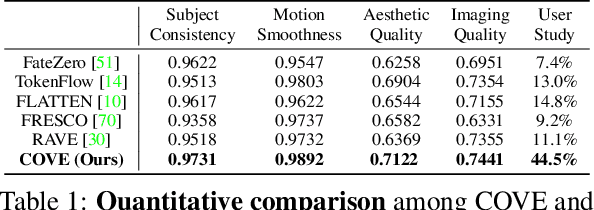
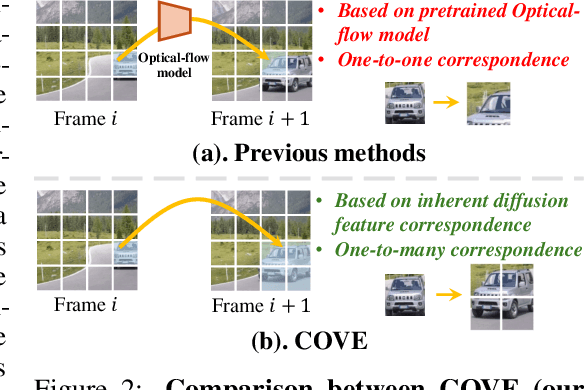

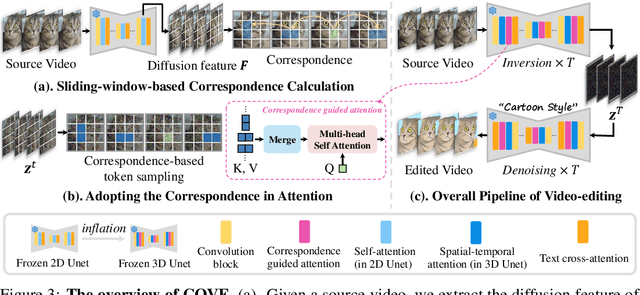
Abstract:Video editing is an emerging task, in which most current methods adopt the pre-trained text-to-image (T2I) diffusion model to edit the source video in a zero-shot manner. Despite extensive efforts, maintaining the temporal consistency of edited videos remains challenging due to the lack of temporal constraints in the regular T2I diffusion model. To address this issue, we propose COrrespondence-guided Video Editing (COVE), leveraging the inherent diffusion feature correspondence to achieve high-quality and consistent video editing. Specifically, we propose an efficient sliding-window-based strategy to calculate the similarity among tokens in the diffusion features of source videos, identifying the tokens with high correspondence across frames. During the inversion and denoising process, we sample the tokens in noisy latent based on the correspondence and then perform self-attention within them. To save GPU memory usage and accelerate the editing process, we further introduce the temporal-dimensional token merging strategy, which can effectively reduce redundancy. COVE can be seamlessly integrated into the pre-trained T2I diffusion model without the need for extra training or optimization. Extensive experiment results demonstrate that COVE achieves the start-of-the-art performance in various video editing scenarios, outperforming existing methods both quantitatively and qualitatively. The code will be release at https://github.com/wangjiangshan0725/COVE
GrootVL: Tree Topology is All You Need in State Space Model
Jun 04, 2024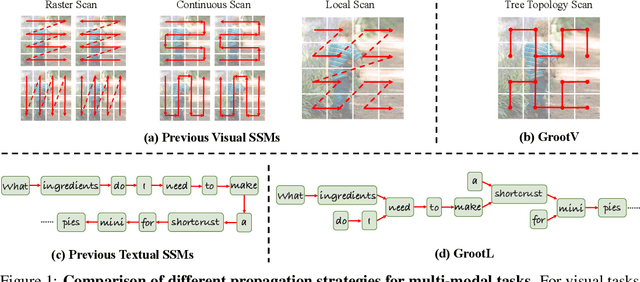
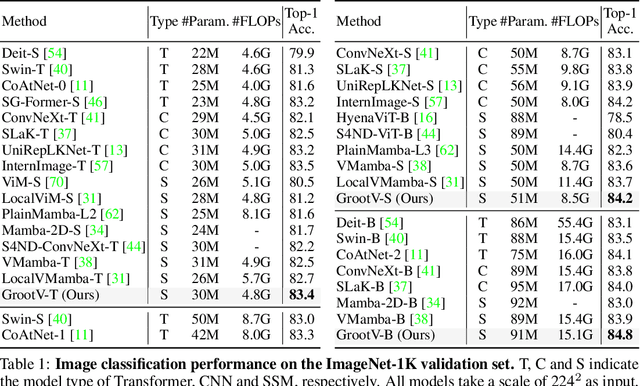
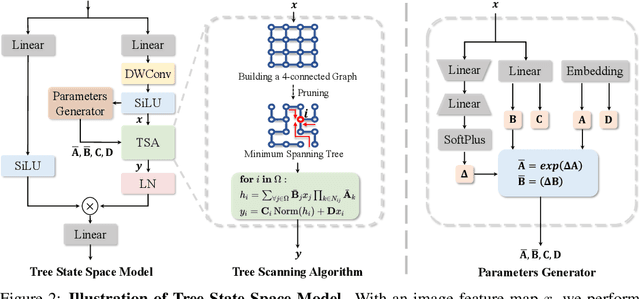
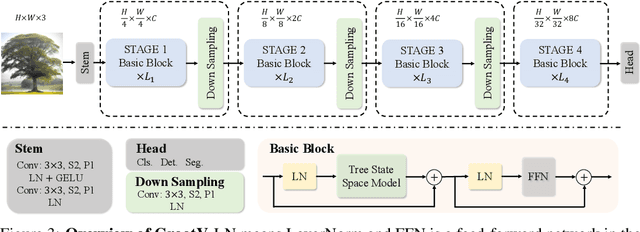
Abstract:The state space models, employing recursively propagated features, demonstrate strong representation capabilities comparable to Transformer models and superior efficiency. However, constrained by the inherent geometric constraints of sequences, it still falls short in modeling long-range dependencies. To address this issue, we propose the GrootVL network, which first dynamically generates a tree topology based on spatial relationships and input features. Then, feature propagation is performed based on this graph, thereby breaking the original sequence constraints to achieve stronger representation capabilities. Additionally, we introduce a linear complexity dynamic programming algorithm to enhance long-range interactions without increasing computational cost. GrootVL is a versatile multimodal framework that can be applied to both visual and textual tasks. Extensive experiments demonstrate that our method significantly outperforms existing structured state space models on image classification, object detection and segmentation. Besides, by fine-tuning large language models, our approach achieves consistent improvements in multiple textual tasks at minor training cost.
GRA: Detecting Oriented Objects through Group-wise Rotating and Attention
Mar 19, 2024



Abstract:Oriented object detection, an emerging task in recent years, aims to identify and locate objects across varied orientations. This requires the detector to accurately capture the orientation information, which varies significantly within and across images. Despite the existing substantial efforts, simultaneously ensuring model effectiveness and parameter efficiency remains challenging in this scenario. In this paper, we propose a lightweight yet effective Group-wise Rotating and Attention (GRA) module to replace the convolution operations in backbone networks for oriented object detection. GRA can adaptively capture fine-grained features of objects with diverse orientations, comprising two key components: Group-wise Rotating and Group-wise Attention. Group-wise Rotating first divides the convolution kernel into groups, where each group extracts different object features by rotating at a specific angle according to the object orientation. Subsequently, Group-wise Attention is employed to adaptively enhance the object-related regions in the feature. The collaborative effort of these components enables GRA to effectively capture the various orientation information while maintaining parameter efficiency. Extensive experimental results demonstrate the superiority of our method. For example, GRA achieves a new state-of-the-art (SOTA) on the DOTA-v2.0 benchmark, while saving the parameters by nearly 50% compared to the previous SOTA method. Code will be released.
Masked Co-attentional Transformer reconstructs 100x ultra-fast/low-dose whole-body PET from longitudinal images and anatomically guided MRI
May 09, 2022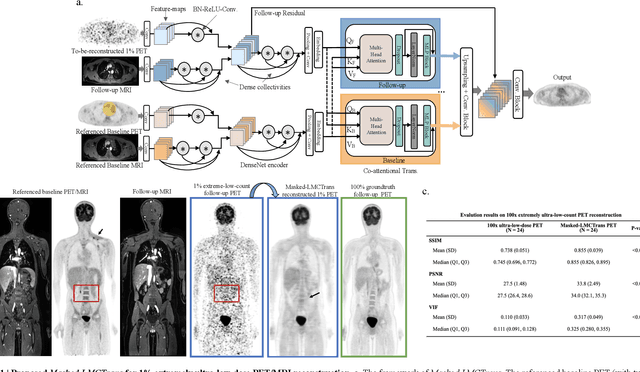
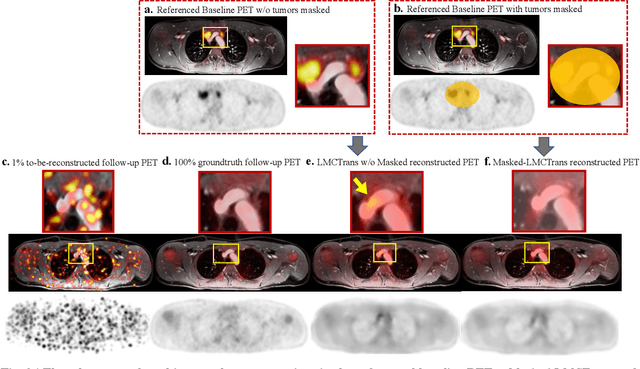
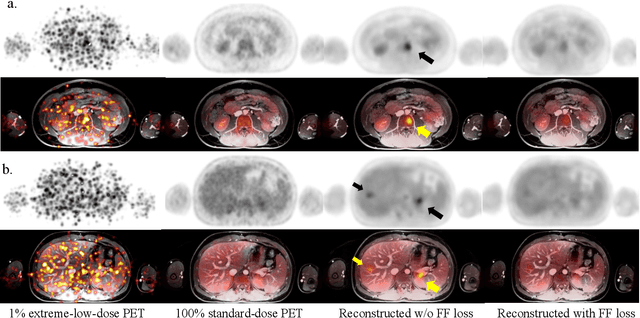
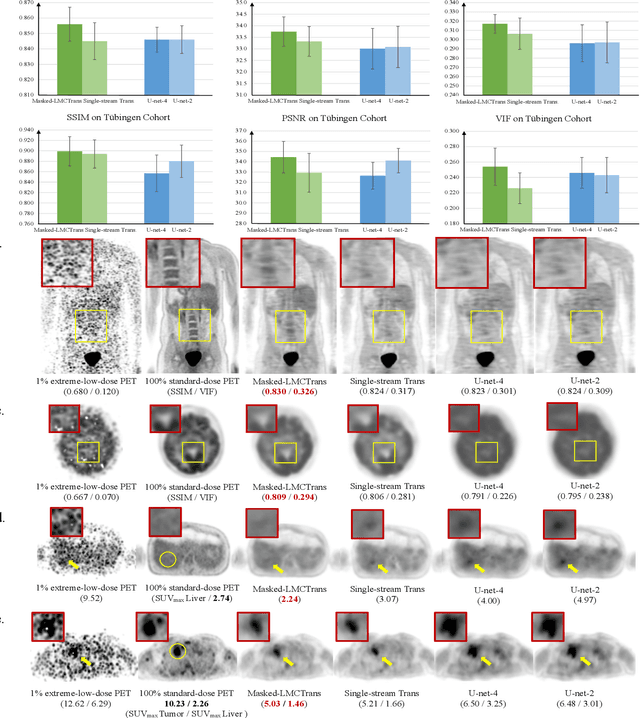
Abstract:Despite its tremendous value for the diagnosis, treatment monitoring and surveillance of children with cancer, whole body staging with positron emission tomography (PET) is time consuming and associated with considerable radiation exposure. 100x (1% of the standard clinical dosage) ultra-low-dose/ultra-fast whole-body PET reconstruction has the potential for cancer imaging with unprecedented speed and improved safety, but it cannot be achieved by the naive use of machine learning techniques. In this study, we utilize the global similarity between baseline and follow-up PET and magnetic resonance (MR) images to develop Masked-LMCTrans, a longitudinal multi-modality co-attentional CNN-Transformer that provides interaction and joint reasoning between serial PET/MRs of the same patient. We mask the tumor area in the referenced baseline PET and reconstruct the follow-up PET scans. In this manner, Masked-LMCTrans reconstructs 100x almost-zero radio-exposure whole-body PET that was not possible before. The technique also opens a new pathway for longitudinal radiology imaging reconstruction, a significantly under-explored area to date. Our model was trained and tested with Stanford PET/MRI scans of pediatric lymphoma patients and evaluated externally on PET/MRI images from T\"ubingen University. The high image quality of the reconstructed 100x whole-body PET images resulting from the application of Masked-LMCTrans will substantially advance the development of safer imaging approaches and shorter exam-durations for pediatric patients, as well as expand the possibilities for frequent longitudinal monitoring of these patients by PET.
Assessing a Single Image in Reference-Guided Image Synthesis
Dec 08, 2021
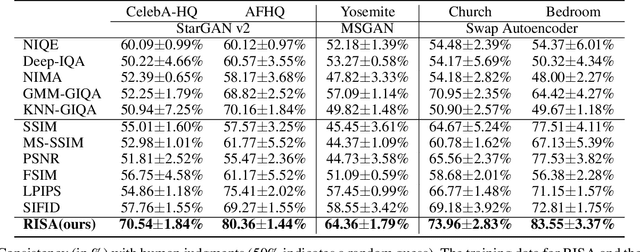
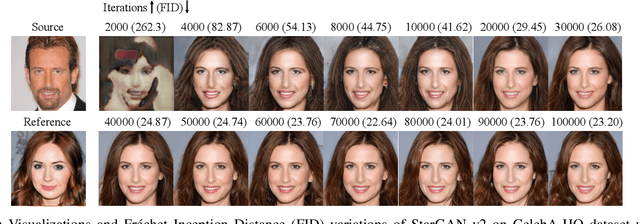

Abstract:Assessing the performance of Generative Adversarial Networks (GANs) has been an important topic due to its practical significance. Although several evaluation metrics have been proposed, they generally assess the quality of the whole generated image distribution. For Reference-guided Image Synthesis (RIS) tasks, i.e., rendering a source image in the style of another reference image, where assessing the quality of a single generated image is crucial, these metrics are not applicable. In this paper, we propose a general learning-based framework, Reference-guided Image Synthesis Assessment (RISA) to quantitatively evaluate the quality of a single generated image. Notably, the training of RISA does not require human annotations. In specific, the training data for RISA are acquired by the intermediate models from the training procedure in RIS, and weakly annotated by the number of models' iterations, based on the positive correlation between image quality and iterations. As this annotation is too coarse as a supervision signal, we introduce two techniques: 1) a pixel-wise interpolation scheme to refine the coarse labels, and 2) multiple binary classifiers to replace a na\"ive regressor. In addition, an unsupervised contrastive loss is introduced to effectively capture the style similarity between a generated image and its reference image. Empirical results on various datasets demonstrate that RISA is highly consistent with human preference and transfers well across models.
 Add to Chrome
Add to Chrome Add to Firefox
Add to Firefox Add to Edge
Add to Edge